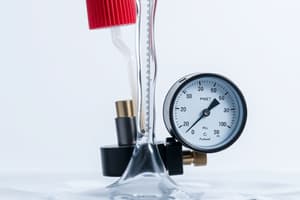Podcast
Questions and Answers
What is absolute pressure?
What is absolute pressure?
The actual pressure at a given position measured relative to absolute vacuum.
What is gauge pressure?
What is gauge pressure?
The pressure relative to the atmospheric pressure.
What are vacuum pressures?
What are vacuum pressures?
Pressures below atmospheric pressure.
Which devices are used to measure fluid pressure?
Which devices are used to measure fluid pressure?
How does a piezometer work?
How does a piezometer work?
What is the formula for pressure measured with a piezometer?
What is the formula for pressure measured with a piezometer?
What type of liquids are typically used in manometers?
What type of liquids are typically used in manometers?
Manometers are expensive and require calibration.
Manometers are expensive and require calibration.
What classifies a simple manometer?
What classifies a simple manometer?
Which of the following is a type of simple manometer?
Which of the following is a type of simple manometer?
What role do mechanical gauges play?
What role do mechanical gauges play?
Flashcards are hidden until you start studying
Study Notes
Absolute, Gauge, Atmospheric, and Vacuum Pressure
- Absolute Pressure: The total pressure at a location measured from a complete vacuum.
- Gauge Pressure: Pressure relative to atmospheric pressure, indicating how much the pressure deviates from atmospheric conditions.
- Vacuum Pressure: Refers to pressures below atmospheric pressure, measured with vacuum gauges that quantify the difference from absolute pressure.
Measurement of Fluid Pressure
- Pressure can be measured using various devices, including:
- Piezometers
- Manometers
- Mechanical Gauges
- Pressure Transmitters
Piezometer
- A device with one open end to atmospheric pressure and another connected to the point where pressure is measured.
- The liquid column's height in the piezometer correlates directly with the pressure at the measured point.
- The pressure at point A is calculated using the formula:
- Pressure = ρ × g × h*, where ρ is the fluid density, g is the gravitational acceleration, and h is the height of the liquid column.
Example of Piezometer Calculation
- For oil with a density of 640 kg/m³ rising to a height of 1.2 m, gauge pressure can be calculated using:
- Pressure = 640 kg/m³ × 9.81 m/s² × 1.2 m*.
Manometers
- Instruments that measure pressure by balancing columns of liquid.
- Typically constructed as U-shaped tubes filled with a liquid like water or mercury.
- Do not require calibration and are cost-effective.
Applications of Manometers
- Used in HVAC systems, low-pressure gas systems, construction, climate forecasting, and clinical settings to measure blood pressure.
Principle of Manometers
- The relationship between pressures in a manometer is given by:
- (p1 - p2) = hρg*
- where p1 is the pressure to be measured and p2 is atmospheric pressure.
- It leads to the rearranged expression:
- p1 = p2 + hρg*.
Types of Manometers
- Simple and Differential Manometers.
- Simple Manometers: One end connected to the pressure source, the other open to the atmosphere.
- Common types include:
- U-tube Manometer
- Well type Manometer
- Inclined Manometer
- Float type Manometer
Mechanical Gauges
- Devices that measure pressure by using an elastic element that deflects under pressure.
- The deflection operates a pointer that indicates pressure on a graduated scale.
Studying That Suits You
Use AI to generate personalized quizzes and flashcards to suit your learning preferences.




